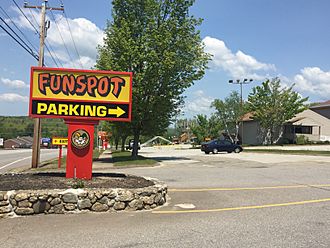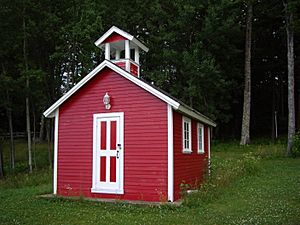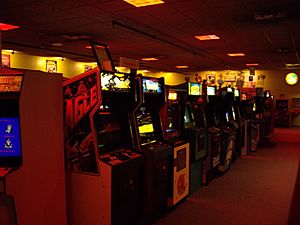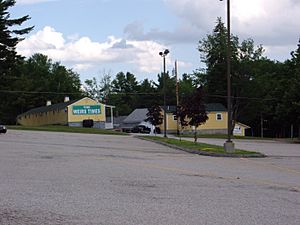Funspot (arcade) facts for kids
Quick facts for kids Funspot |
|
|---|---|
 |
|

Entrance to Funspot
|
|
| Former names | Weirs Sports Center |
| General information | |
| Type | Video arcade |
| Address | 579 Endicott Street North |
| Town or city | Weirs Beach, Laconia, New Hampshire |
| Country | United States |
| Opened | June 27, 1952 |
| Relocated | 1964 |
Funspot is a super cool arcade located in Weirs Beach, New Hampshire, USA. It's famous for having one of the biggest collections of old-school video games and pinball machines in the world!
This awesome place was started in 1952 by Robert M. Lawton. Today, Funspot has over 600 games, including classic arcade games, modern video games, and pinball machines. You can also find an indoor miniature golf course, 20 lanes for ten-pin and candlepin bowling, and even cash bingo. If you get hungry, there's a restaurant, an ice cream stand, and a tavern. There are also fun kiddie rides and other attractions.
In 2008, Funspot was officially named the "Largest Arcade in the World" by Guinness World Records. This happened during their 10th Annual International Classic Video Game and Pinball Tournament.
Funspot was first called the Weirs Sports Center. It was located across the street from the Weirs Beach boardwalk. In 1964, it moved to its current, bigger home on Route 3. The American Classic Arcade Museum section of Funspot always has about 300 games from the 1970s, 1980s, and 1990s ready to play.
Funspot is also home to The American Classic Arcade Museum. This is a special non-profit group that works to save and share the history of coin-operated arcade games. It's located on the third floor of Funspot.
Contents
Funspot's History
Funspot first opened its doors on June 27, 1952. It was called the Weirs Sports Center back then. It was on the top floor of the Tarlson's Arcade building, right across from the Weirs Beach boardwalk.
The founder, Robert M. Lawton, was only 21 years old when he started it. He borrowed $750 from his grandmother to open an indoor miniature golf course and a penny arcade. On its very first day, the center made $36.60 from mini-golf and $5.60 from selling soft drinks. A round of 9-hole mini-golf cost 35 cents!
Moving to a New Home
In 1964, Funspot as we know it today was created. Robert Lawton bought 21 acres of land, which is where Funspot is now. He moved his fun business there. The first thing built was a miniature golf course and a building next to it. This course became known as the "Landmarks of New Hampshire" mini-golf course.
A small clubhouse was also built. In 1965, it was made much bigger, becoming a 4,000 square foot billiards room. This was just the first of many additions to Funspot over the years.
Past Theme Parks
In 1971, Funspot opened its first of two theme parks on its Route 3 property. It was called "Indian Village." This park showed life-size homes and buildings from different Native American cultures across North America. Indian Village closed in 1983.
A second theme park, Storybook Forest, opened in 1976. This park was based on children's nursery rhymes and fairy tales. One cool part was "Gingerbread Man Pond," a pond shaped like a running gingerbread man. It had two big buttons that led to Robinson Crusoe's hut and cave. There were also many fiberglass statues of story characters. You can still see some of these statues in the children's areas of Funspot today. When Storybook Forest closed, most attractions were removed, except for the red school house.
Growth and Changes
In 1980, Funspot changed from using quarters to using tokens for its games. Over the years, Funspot grew and even opened other locations in different towns. These included places in Wolfeboro, Concord, Dover, and Amherst in New Hampshire. There were also locations in South Portland, Maine, and Port Richey, Florida.
By the mid-1990s, these other locations had closed. The Florida location became another arcade called Stop N' Play, which is still open. The bowling center, with both ten-pin and candlepin bowling, was added to Funspot in 1988. The bingo hall was added in 1996.
In 2008, Guinness World Records officially named Funspot the "World's Largest Arcade." The American Classic Arcade Museum inside Funspot has about 180 video games and pinball machines made before 1988. In 2015, the outdoor mini-golf course was moved inside to the third floor. Now, it's open all year round!
American Classic Arcade Museum
The third floor of Funspot is home to the American Classic Arcade Museum.
Gary Vincent, who works at Funspot, is also the president and curator of this museum. He started this non-profit group to collect classic games. The goal is to save the history of old coin-operated games. The museum opened in the late 1990s. It accepts donations of games made no later than 1989.
The museum usually has 250 games ready to play at any time. A writer from The Boston Globe once called the museum "the Louvre of the '8-bit' world." This means it's a very important place for classic video games.
Tournaments and Records
From 1999 to 2014, the American Classic Arcade Museum hosted the Annual Classic Videogame and Pinball Tournament. People came from all over the world to try and break records on the arcade games. Referees from Guinness World Records were there to check if the new records were real. At the 10th tournament alone, more than 20 new records were set! Famous gamers like Billy Mitchell, Steve Wiebe, and Brian Kuh have set records at the museum.
In the late 1980s, fewer people were interested in arcade games. Funspot started selling some of its games. But once the museum started, it began looking for popular games from the past. The museum buys some games online and gets many donated. Sometimes, games that don't work are donated. It can take years to fix them and get them ready to play again.
The American Classic Arcade Museum has been featured in many articles and TV shows. It was shown on Boston Chronicle, New Hampshire Chronicle, and an episode of Mysteries at the Museum. In 2007, parts of the documentary The King of Kong were filmed in the museum and other areas of Funspot.
Funspot's Symbols
Funspot got its name from a magazine that founder Robert M. Lawton read. He asked the magazine if he could use the name for his business, and they said yes!
In 1965, Bob Montana, the creator of the Archie comic series, drew the jester that you see on every Funspot token. Montana lived nearby in Meredith, New Hampshire. He drew the jester to look like his famous character, Jughead. Funspot's mascot is a dragon named "Topsnuf." If you spell "Topsnuf" backwards, it spells "Funspot"!
Other Projects by Funspot's Founder
Robert M. Lawton, the founder of Funspot, has also started other projects in the community. These are not directly part of the family entertainment center. For example, some of Funspot's charity bingo games have helped different non-profit groups.
Lake Winnipesaukee Historical Society
The Lake Winnipesaukee Historical Society and Lake Winnipesaukee Museum are located right next to Funspot. Robert M. Lawton and his son Tim Lawton started the historical society in 1985. The museum has information and displays about the history of Lake Winnipesaukee and the towns around it. Many of the old items were found by Bob and Tim during their scuba diving trips in the lake. The museum building opened in 2004 and has been made bigger to include a modern area for guest speakers.
The Weirs Times Newspaper
The Weirs Times is another project Robert M. Lawton started. The original "Weirs Times and Tourist's Gazette" was a newspaper published from 1883 to 1902. Robert M. Lawton started publishing a new weekly paper with the same name and a map of Lake Winnipesaukee in June 1992. It first focused on the towns around Lake Winnipesaukee. Now, this weekly paper prints 30,000 copies!
Miss Winnipesaukee Scholarship Program
Funspot used to host the Miss Winnipesaukee Scholarship Program. It started hosting it in 1969 and continued for several years. However, Funspot is no longer a sponsor of this program.




